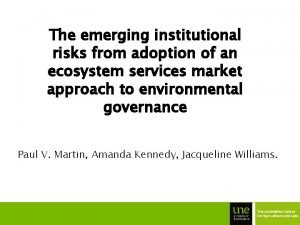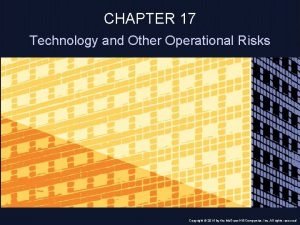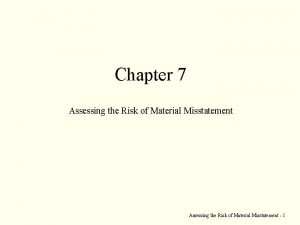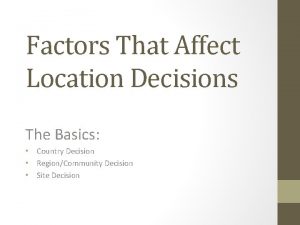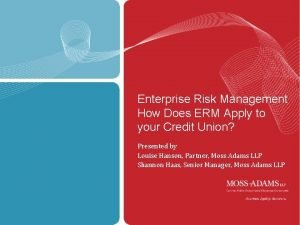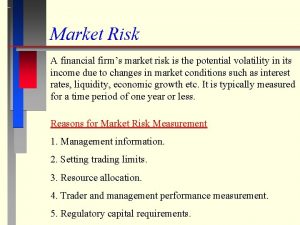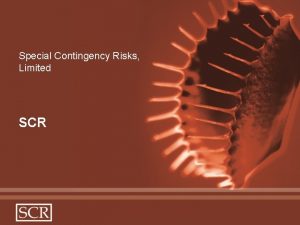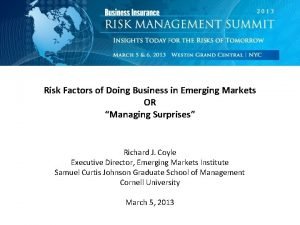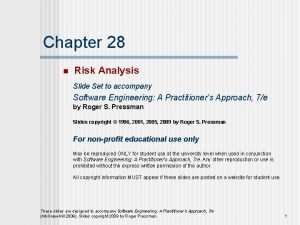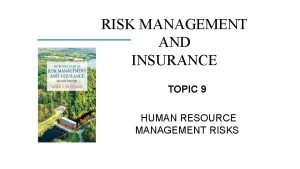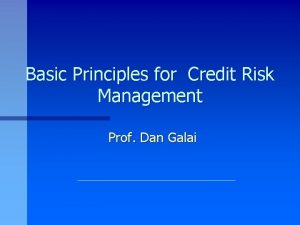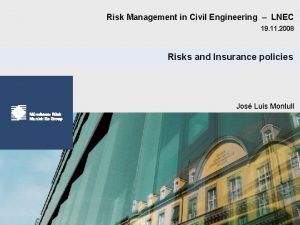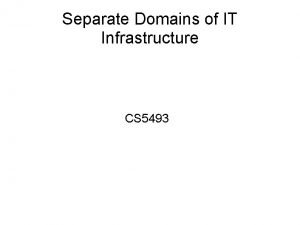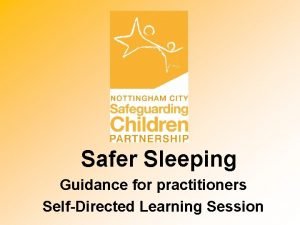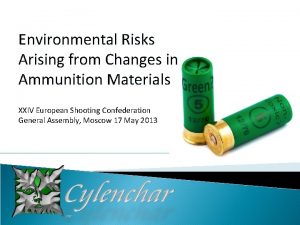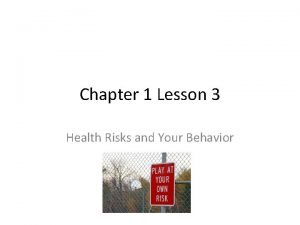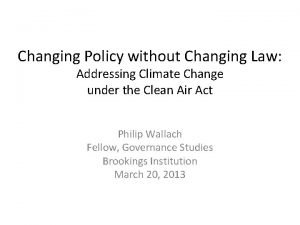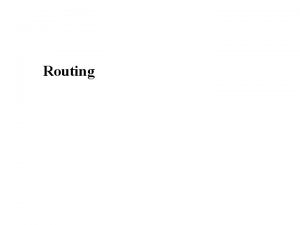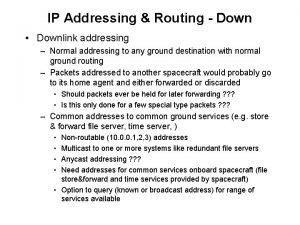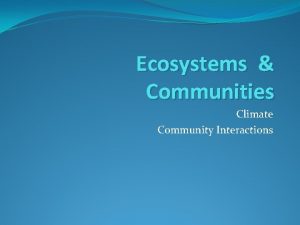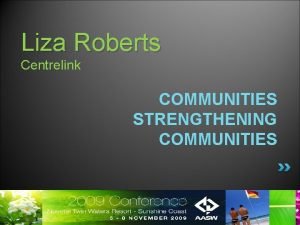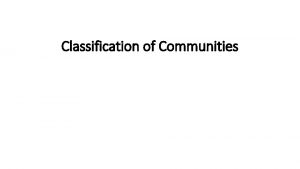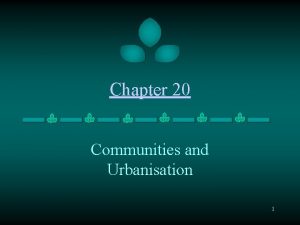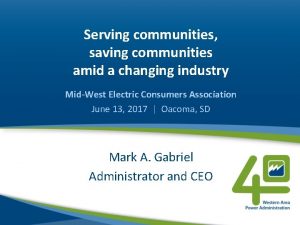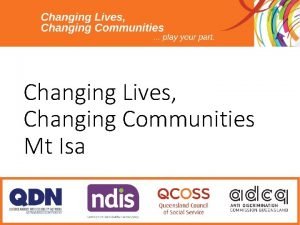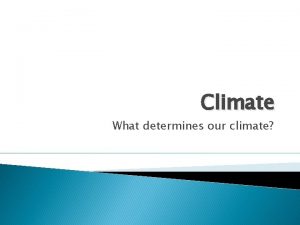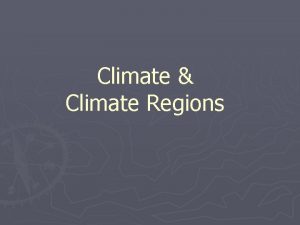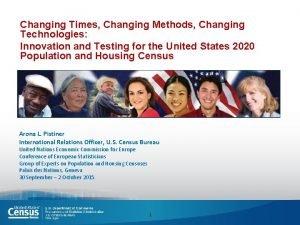Addressing risks with communities in a changing climate




















- Slides: 20

Addressing risks with communities in a changing climate Climate Training Kit. Module 2 – What can we do. 2 D Addressing risks with communities in a changing climate

Session summary 1. Why incorporate climate change into community assessments 2. What steps can be taken to make risk assessments climate-smart? Photo: Danish Red Cross • before • during • after. 3. Some points to consider Climate Training Kit. Module 2 – What can we do. 2 D Addressing risks with communities in a changing climate

Keep in mind… • This guidance is based on an understanding of the IFRC’s toolboxes for Vulnerability and Capacity Assessment (VCA) and Community-Based Health and First Aid (CBHFA). • The aim is to build climate variability and change into the existing tool boxes – not create new ones. We assume you’ve already looked at CTK: 1 a Science and impacts 2 b Using forecast information Climate Training Kit. Module 2 – What can we do. 2 D Addressing risks with communities in a changing climate

Local experts In many parts of the world, communities are already noticing changes to climate and weather patterns or “funny” weather Climate Training Kit. Module 2 – What can we do. 2 D Addressing risks with communities in a changing climate

Local experts “More and more floods. ” “Rains no longer normal – difficult to know when to plant. ” “Our paddy fields get eaten away by sand dunes and the sea. ” Climate Training Kit. Module 2 – What can we do. 2 D Addressing risks with communities in a changing climate

Remember • Communities face many challenges, and climate change needs to be considered alongside. • It is not possible to determine if any one weather-related disaster is caused by climate change – all risks need to be considered. Photo: Danish Red Cross Climate Training Kit. Module 2 – What can we do. 2 D Addressing risks with communities in a changing climate

Plan the VCA/CBHFA Seeking background information in advance can help determine: • Where to do the VCA/CBHFA • Who to do the VCA/CBHFA with (draw more on elderly people’s experience) • What questions to ask to include climate concerns in analysis and planning Please refer to the exercise in this module: Brainstorming climate information sources. Climate Training Kit. Module 2 – What can we do. 2 D Addressing risks with communities in a changing climate

Considering climate change in VCA/CBHFA tools • Seasonal calendar • Observation • Community mapping: • Spatial map • Hazard/risk/vulnerability map • Capacity and resource map • Transect map • Historical calendar • Institutional and social network analysis • Livelihood analysis • Interviews – key informants Photo: Danish Red Cross Please refer to the exercise in this module: Considering climate change in VCA tools Climate Training Kit. Module 2 – What can we do. 2 D Addressing risks with communities in a changing climate

Solomon Islands (Pileni Island) Month Jan Weather Health Changes in wind patterns, more storm surges Food No breadfruit season compared to past Feb Mar April Expect rainy, but now windy May Jun Jul Usually get cold and flu in wet season, now in dry season Sun very hot now Aug Sept Should be low tide from April–September, but now high tide more often Main harvest time, but now harvest is small Oct Nov High tide (November. January) Dec Climate Training Kit. Module 2 – What can we do. 2 D Addressing risks with communities in a changing climate

Another example from Pacific National Societies Climate Training Kit. Module 2 – What can we do. 2 D Addressing risks with communities in a changing climate

What can a facilitator decide to do? • Option A (easier): Don’t mention climate change in your contact with communities. Provide climate information only as a background for the facilitators conducting the VCA/CBHFA. • Option B (medium difficulty): Faciliate discussion with the community about changes in climate by asking questions about weather patterns. • Option C (more difficult): Introducing climate change. Help communities understand prepare for the future by bringing in information about climate change (see Module 3 b on How!). Climate Training Kit. Module 2 – What can we do. 2 D Addressing risks with communities in a changing climate

Discuss changes with the community In the facilitation, use information provided from elders and others to reflect the community’s experience: • How did they deal with past events? • What if the events became more intense and frequent? • What can the community do to prepare? The answers can help in adjusting the community risk-reduction plan to become more climate-smart. Climate Training Kit. Module 2 – What can we do. 2 D Addressing risks with communities in a changing climate

Climate information flow Community information e. g. group discussion, seasonal calendar, historical profile Decision making Community risk reduction plan Outside information e. g. Meteorological Office, climate change focal point Sharing information further – advocacy e. g. local government, early warning policy-makers Climate Training Kit. Module 2 – What can we do. 2 D Addressing risks with communities in a changing climate

Analyse information from the community • Cross-check the data from the community with other sources whether community observations and scientific observations match up [such as: does community reports of changing flood events match with the statistics from meteorological department? ] • If not: seek an explanation. Maybe the data isn’t good in the area. Maybe environmental degradation or changing land use are playing a role in the changes observed? • This can inform the planning and how the community can seek to address rising risks. • If yes: is it a priority for the community to address rising risks that have been observed? And can it realistically be considered in the overall ‘community risk reduction plan’? Climate Training Kit. Module 2 – What can we do. 2 D Addressing risks with communities in a changing climate

A matrix to help the analysis Changes observed by the community Are the changes good or bad? Why? Possible reasons for changes Evidence based on scientific information Other factors that may explain changes observed by communities Example 1. Sea eroding the coastline Bad: affects infrastructure close to sea, inundates food gardens Sea level rising 8 mm per year in Solomon Islands Some sand mining along coastline Example 2. Getting hotter in the summer Bad: old people can’t cope when its very hot Temperature rising Good: can grow more crops in summer Example 3. Flooding more often Bad: River rises more quickly and more often these days Meteorological office reports that no change in extreme rainfall events Logging present upstream, probably affecting flow Climate Training Kit. Module 2 – What can we do. 2 D Addressing risks with communities in a changing climate

Developing community action plans • How might information collected before and during the VCA/ CBHFA be best considered in community risk-reduction plans? • What could the community itself address, and what would required external support and collaboration? • Do we invite government and civil society involvement if appropriate? Photo: Danish Red Cross Climate Training Kit. Module 2 – What can we do. 2 D Addressing risks with communities in a changing climate

What next? Follow up with community • Just like with any VCA/ CBHFA, follow-up in the community is essential. • It is important to monitor progress so that lessons can be learned from approaches you tried. Climate Training Kit. Module 2 – What can we do. 2 D Addressing risks with communities in a changing climate

What next? Sharing information for advocacy Information about changes a community is observing, and the action plans they have come up with to deal with changing risks can be used outside the Red Cross Red Crescent: • In recommendations for local governments to support practical climate change adaptation projects, on a local and a national scale • Advocate for support and collaboration to tackle concerns too large for local communities and the Red Cross Red Crescent to address • For fund-raising from adaptation funding lines, national and international Photo: Danish Red Cross See module 3 a Policy dialogue Climate Training Kit. Module 2 – What can we do. 2 D Addressing risks with communities in a changing climate

Source: NASA What about other natural variations in climate such as La Niña and El Niño? • Some parts of the world are heavily affected by year to year variability in rainfall due to factors such as El Niño and La Niña. You might gather information about this before the VCA. • Communities may receive some early warning on these, or perhaps they don’t. • A VCA/CBHFA may provide an opportunity to discuss preparedness for these events. • You can contact the Climate Centre if you would like assistance in trialling this. And see Module 2 b Using forecast information (early warning) Climate Training Kit. Module 2 – What can we do. 2 D Addressing risks with communities in a changing climate

Final points • Start where you feel comfortable! • Capacity building of field staff is a critical element. • Take a look at the Practitioners Guidance. Photo: Danish Red Cross Climate Training Kit. Module 2 – What can we do. 2 D Addressing risks with communities in a changing climate
 Flat addressing vs hierarchical addressing
Flat addressing vs hierarchical addressing Why is primary succession an orderly process
Why is primary succession an orderly process Climate change 2014 mitigation of climate change
Climate change 2014 mitigation of climate change Partially concealed
Partially concealed Technology and operational risk
Technology and operational risk Balfour beatty 6 fatal risks
Balfour beatty 6 fatal risks Risk of material misstatement table
Risk of material misstatement table Country decision
Country decision Credit union enterprise risk management
Credit union enterprise risk management Market risk definition
Market risk definition Scr limited
Scr limited Risks of doing business in emerging markets
Risks of doing business in emerging markets Risks and mitigation slide
Risks and mitigation slide Human resource risks examples
Human resource risks examples Types of credit risk
Types of credit risk Civil engineering completed risks insurance
Civil engineering completed risks insurance 7 domains of it infrastructure
7 domains of it infrastructure Lullaby trust spot the risks
Lullaby trust spot the risks Material selection risks
Material selection risks Physical hazards
Physical hazards Chapter 1 lesson 3 health risks and your behavior
Chapter 1 lesson 3 health risks and your behavior



